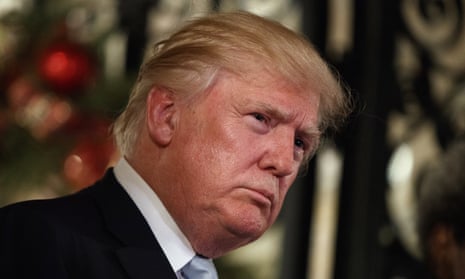President-elect Donald Trump says he wants to keep Guantánamo open. He wants to “load it up” with “bad dudes”, just like George W Bush wanted to in 2001. Trump says waterboarding is not tough enough, even though it was tough enough for the Spanish Inquisition.
Of course, who really knows with Trump? When you consider that he looks like the warning label on cocaine and talks like someone trying to recall the last moments of a car crash, few of his pronouncements can be taken at face value. Translating Trump is like trying to work out why a newborn baby is crying. He might well make good on his promise to restock Guantánamo, or we might get lucky and he’ll be too busy building a pyramid.
Now that Trump has been elected leader of the nominally free world, democracy has jumped the shark. But absurdity is nothing new to Guantánamo – a place where peaceful hunger strikes (the last remaining form of protest for detainees) are renamed “non-religious fasts” and suicide is described as SIB – self-injurious behaviour, or “an act of asymmetrical warfare”. It’s a place where even books make the authorities uneasy – Crime and Punishment and Uncle Tom’s Cabin have been banned, along with Jack and the Beanstalk. Thankfully, Reprieve director Clive Stafford Smith is still allowed in – but his books are not (which he tells me is one of the few kindnesses the guards have shown to the prisoners).
When Guantánamo first opened, we were told that the people held there – without charge or trial – were the “worst of the worst”. Then, as details started to trickle out, along came the bounty flyers too. They offered $5,000 for any bearded foreign-looking guy you didn’t like, which is a lot of money in some parts of the world. At the time it was equivalent to maybe a quarter of a million pounds in Britain.
Bounties and a general atmosphere of vengeful chaos have led to Guantánamo’s farcical intake. A chap called Mohammed el Gharani was just 14 when he arrived at the prison. He’d been sold to the Americans for a bounty, and they were sure he was a bad dude. Mohammed had grown up in Saudi Arabia, and travelled to Karachi in 2001 to study English. He never went near Afghanistan until the Americans took him there, and started interrogating him with a Yemeni translator. The word “zalat” means “salad” in Saudi dialect, but it means “money” in Yemeni. They demanded to know what “zalat” he’d taken to Pakistan and he thought they were weird. No, he said, he had none, as he could get “zalat” wherever he needed it.
So the CIA guy decided he was an al-Qaida financier and demanded to know his sources. He listed the vegetable stalls near his boarding house, and the Americans wrote it down. Mohammed did six years in Guantánamo as a 26-year-old financier, before his Reprieve lawyers arrived and suggested checking his birth certificate.
Then there was the al-Jazeera journalist Sami al-Haj, who was held for over six years. Or take Emad Hassan, from Yemen. Asked by his US interrogators if he “knew” al-Qaida, Emad said yes, of course he knew it. Al-Qa’idah is a town in Yemen. His Reprieve lawyers found it on Google Earth.
Today, 55 prisoners remain at Gitmo. They include Haroon Gul, an Afghan refugee brought there in 2007 after he was mistaken for another man, and Ahmed Rabbani, a Karachi taxi driver who was mistaken for a man called Hassan Ghul, and tortured in the “dark prison” for 540 days. These 55 prisoners are held on the basis of a hotchpotch of often ridiculous statements and wishful thinking that emerged from the worst abuses of the Bush-era torture programme.
We now know all this because organisations such as Reprieve have investigated these cases and exposed the truth to the world. Thankfully, 724 detainees have been released since 11 January 2002, and the prison is almost empty. But now it looks like we’ve come full circle – thanks to Trump. He’s once again telling us that we need to keep people locked up in Guantánamo without charge or trial for our protection.
Of course, Trump has a lot of Americans worried, even if it’s just that the colour on their TV might be broken. In the early days of his presidency, Americans will feel like some country in the middle ages that had a five-year-old king. Many are hoping that at least there’s some White House aide whose job it is to hide Xanax in his food like he was a cat. At Guantánamo, the US government has given us 15 years of injustice, 15 years of catastrophic mistakes – all while trying to convince us that they are holding the worst of the worst. If Trump really does commit to more of this madness, he will have achieved the impossible: being an even worse president than we’d imagined.

